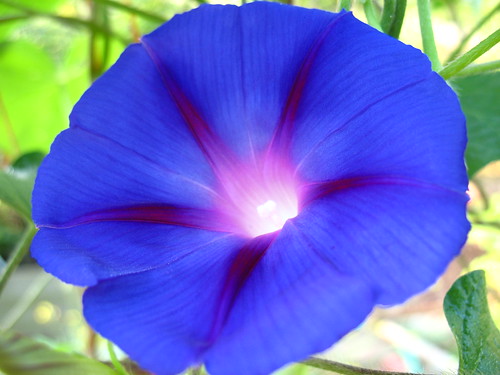 |
| This is not a blue petunia, it is a morning glory. Screen shot from NY Times website, Jan 6, 2014, by BotanicalAccuracy.com |
Now, the only problem is that this is not a petunia. Petunias are members of the genus Petunia (simple!) in the Solanaceae, the potato family. This is unfortunately a photo of a morning glory, in the genus Ipomoea in the family Convolvulaceae, related to sweet potatoes. There are several kinds of morning glories, all in the same family, and both morning glories and petunias come in a wide array of flower color patterns.
The very interesting research article has the right plant in its illustrations.
 |
| Illustration showing the mutation that causes blue petunias. Image (c) Faraco et al. (2014) [Cell reports 10.1016/j.celrep.2013.12.009] |
 |
| The source of the wrong petunia image. Screen shot from iStock by Getty Images website, Jan 6, 2014, by BotanicalAccuracy.com |
Here is a petunia:
 |
| Petunia flower. Public domain photo by Zirguezi. |
Here is a morning glory:
 |
| Blue morning glory flower. (cc) Vilseskogen on Flickr. |
UPDATE 1: It seems that the wrong photo was first used by the renowned science magazine Science [!!!] in their highlight of this research. See their article titled "ScienceShot: Broken Pump turns petunias blue", dated Jan 2, 2014. So The New York Times probably just reused the photo provide by Science. Here is the screenshot:
 |
| The first use of the wrong petunia image, in Science. Screenshot from Science Magazine, on Jan 5, 2014, by BotanicalAccuracy.com |
 |
| Another morning glory presented as a petunia. Screenshot from International Business Times website, Jan 7, 2014, by BotanicalAccuracy.com. |
 |
| A new photo with abundant and correct petunias on the corrected Science web page. Screenshot from Science magazine website, Jan 9, 2014, by BotanicalAccuracy.com. |
UPDATE 5: New York Times removed the photo for their article and provided a correction on Jan 10, 2014. Thank you!
